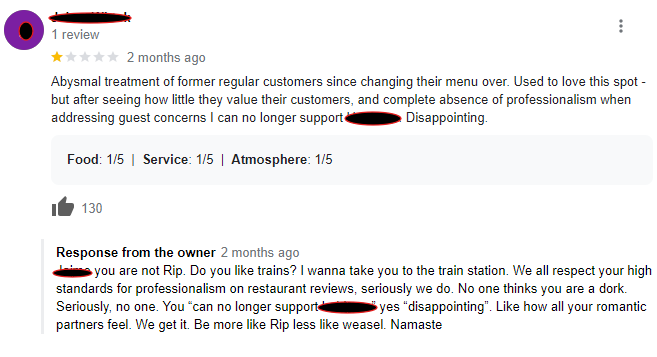Why Angry Customers Are Good For Your Business
The customer is always right…or are they?
The infamous saying “The Customer is always right” is a cornerstone of customer service philosophy. But are they always right?
When you know you are in the right when dealing with a customer, you may have to swallow your pride. Yes, there may be times when someone is enraged or simply unreasonable. It’s sometimes best to let things go and move on. These extreme cases are often few and far between, though. Ensuring that customers don’t feel wrong in such situations is crucial, as our previous article, “The Effects Of Unhappy Customers,” explains why handling angry customer situations effectively is essential.
But how do you go about doing that? Here are some reminders:
- Maintain a Positive Attitude: Frequently use phrases like “thanks”, “I understand” and “thank you for your feedback.”
- Assume Honesty: Believe that the customer is genuine when they complain.
- Assume Misunderstanding: There is likely a genuine misunderstanding at play.
Throughout this article, we will cover everything from getting an angry customer and turning their anger into being one of your biggest advocates, to tips on ensuring you keep your customers.
angry customers are good for your business
A dissatisfied customer can be a great source of learning for you and can also become a happy customer if you handle them in a positive manner. From my experience, I would like to say that an angry customer is not bad for business; it can be used to improve your business. Using the correct approach and supporting information, you can turn an angry customer into a happy customer.
In fact, it is often easier to turn around a customer by addressing their concerns than it is to generate new business. This concept ties directly into the importance of customer retention. It costs less to retain a content client than to attract a new one, reducing the overall customer acquisition cost. Thus, understanding customer retention meaning and implementing effective customer retention strategies are crucial for business success.
“Your most unhappy customers are your greatest source of learning.”
— Bill Gates, philanthropist and Founder of Microsoft
how to turn an angry customer into a happy one
Customers can be fickle. They want something, then they don’t, and then they want it again. One thing that is certain, however, is that an angry customer can hurt your business. That’s why it’s so important to keep them happy. The problem is, customers don’t always know how to make themselves heard and it’s on you to listen.
An example of what NOT to do and yes this is a REAL response:

We have created a list of 12 tips on how to deal with angry customers and although there are situations that may need a little more or less work than others, always look at it from the customer’s point of view. You will create some of your best and longest-lasting customers from solving a situation than not.
1. answer quickly
Respond promptly to their complaint to show that their concerns are a priority. For instance, if a customer emails about a defective product, reply within a few hours to acknowledge their issue.
2. answer thoughtfully
Provide a thoughtful response that addresses their specific concern rather than a generic reply. If a customer is upset about a delayed shipment, explain the reason for the delay and steps being taken to expedite their delivery.
3. answer honestly
Always be truthful about the situation. If there’s a mistake on your end, admit it. Transparency builds trust. For example, if a product is out of stock, don’t promise an unrealistic delivery date. Be upfront about when they can expect it.
4. keep your cool
Maintain composure and avoid responding emotionally. For example, if a customer is yelling over the phone, stay calm and listen without interrupting, which helps de-escalate the situation.
5. give each response a custom response
Tailor your response to the customer’s specific situation. If a customer received the wrong item, address them by name and refer to their specific order number and issue in your reply.
6. restate what your customers have said
This shows understanding and empathy. For example, if a customer complains about a poor service experience, say, “I understand you’re frustrated because you had to wait an hour for assistance.”
7. thank them
Express gratitude for bringing the issue to your attention. For instance, “Thank you for letting us know about this issue. Your feedback helps us improve.”
8. describe the steps to solve the problem
Be clear about how you will address their concern. For example, “We will replace the damaged item and have it delivered to you by Friday. We are also providing a discount on your next purchase as an apology.”
9. decide on a time to contact them again
Follow up to ensure the issue is resolved. For example, “I will check back with you next Tuesday to make sure the replacement has arrived and meets your expectations.”
10. be genuine
Authenticity goes a long way in building trust. Speak to them like a human, not a robot. If a customer is upset about a billing error, personally assure them that you will handle the correction and keep them updated.
11. highlight the importance of the case
Show that you value their feedback and are committed to resolving their issue. For instance, “Your experience is very important to us, and we are taking immediate steps to ensure this doesn’t happen again.”
12. follow up with them in the near future
Check-in after the issue has been resolved to ensure continued satisfaction. For example, a week after resolving a complaint about a service failure, send an email asking if everything is now to their satisfaction and if there’s anything more you can do.
By addressing these points thoughtfully and consistently, businesses can turn negative experiences into opportunities to build stronger customer relationships, ultimately enhancing loyalty and long-term success.
the role of customer feedback
By gaining an outsider’s perspective, you can identify blind spots and areas for improvement that may have gone unnoticed otherwise. This can ultimately lead to increased customer satisfaction and loyalty, as well as a stronger competitive advantage in your industry.
Regularly seeking feedback from a diverse range of customers ensures that you are meeting their needs and expectations and helps you identify areas for improvement. Responding promptly and transparently to negative feedback can help turn a dissatisfied customer into a loyal one, further boosting your customer retention rate.
Search Engine Journal would agree, in their article How Negative Reviews Help as they list their 3 reasons.
- Negative Reviews Provide Authentic SEO – Help improve your overall SEO & visibility in search.
- Negative Reviews Build Brand Trust & Loyalty – Increase trust, loyalty, and customer base.
- Negative Reviews Help Improve Business Operations & Profits – Give insights into how you can improve your business for future growth.
the importance of customer experience
Customer experience is the overall perception that customers have of your brand based on their interactions with it. Providing a positive customer experience is crucial for customer retention. Satisfied customers are more likely to stay loyal to your brand, increasing their customer lifetime value.
personalization
Personalization, a strategy that uses customer data and analytics, allows businesses to tailor interactions to meet individual customer needs, enhancing the customer experience and setting a company apart from competitors.
consistency
Consistency in customer experience is crucial for building trust and reliability. It involves uniform branding, messaging, and service standards across all touchpoints, fostering a strong positive association with the brand, ensuring efficient service across all platforms.
efficiency
Efficiency in today’s fast-paced world involves seamless interactions and prompt problem resolution. Streamlining processes and using technology, like chatbots and well-trained customer service teams, can enhance customer experience by providing instant responses and a lasting positive impression.
continuous improvement
To enhance customer experience, businesses must continuously improve by gathering and analyzing customer feedback, staying updated on industry trends, and adapting their approach based on customer insights, demonstrating a commitment to meeting customer needs.
technology integration
Advanced technologies like AI, machine learning, and CRM systems can enhance customer experience by understanding behaviour, predicting needs, and personalizing interactions. AI-driven analytics can identify patterns and trends, proactively addressing issues.
By focusing on personalization, consistency, efficiency, continuous improvement, and technology integration, businesses can create a robust customer experience strategy that not only meets but exceeds customer expectations. This, in turn, fosters customer loyalty, drives repeat business, and ultimately contributes to long-term business success.
the role of a customer retention strategist
Now when we say ‘angry customers are good for business’ we don’t mean on a continuous basis which is why there should be a Customer Retention Strategist (CRS) on the team. A CRS plays a critical role in customer retention by ensuring that customers achieve their desired outcomes while using your product or service. By focusing on customer success, CRSs not only help in resolving issues but also foster a deeper, more meaningful relationship between the customer and the company. Their multifaceted role includes proactively engaging with customers, providing value, and advocating for customers within the company. Let’s delve deeper into each of these responsibilities.
proactively engaging with customers
Regular customer check-ins help identify and mitigate risks early, ensuring customer satisfaction and loyalty. CRSs can gather valuable feedback on customer usage patterns and suggest improvements through scheduled meetings, follow-up emails, or personalized outreach. Offering assistance or training to new customers can enhance their overall experience and satisfaction.
providing value
CRSs actively engage with customers to ensure they are fully benefiting from their product or service. They educate them on features, best practices, and updates, reducing churn and enhancing efficiency. This can be achieved through webinars, tailored guides, or one-on-one training sessions.
advocating for customers
Customer Retention Strategists (CRSs) are crucial in ensuring customer needs and concerns are heard and addressed within a company. They act as a bridge, relaying feedback to departments and advocating for improvements. CRSs also help align the company’s offerings with customer expectations and requirements.
driving customer success through metrics and analysis
CRSs monitor customer metrics to identify trends and issues, tailoring strategies to meet individual needs. By analyzing usage data and satisfaction scores, they can proactively address declines in customer engagement, retain customers and provide insights for improving the product and customer experience.
building long-term relationships
CRSs build long-term customer relationships by understanding business goals and challenges, offering strategic advice, and fostering loyalty. They understand seasonal business cycles, proactively offering tailored solutions, and enhancing customer experience and satisfaction.
By proactively engaging with customers, providing value, advocating for their needs, driving success through metrics and analysis, and building long-term relationships, Customer Retention Strategists play an indispensable role in ensuring customer satisfaction and retention. Their efforts not only help in addressing current issues but also in anticipating future needs, thereby driving sustained business growth and customer loyalty.
customer retention strategies you can put in place today
Effective customer retention strategies are essential for maintaining a loyal customer base and achieving long-term business success. By focusing on retaining existing customers, businesses can reduce churn rates and enhance customer lifetime value. Here are some key strategies to consider:
1. loyalty programs
Loyalty programs reward repeat customers with discounts, points, or exclusive offers, incentivizing frequent purchases and fostering a sense of community. A well-structured program can encourage frequent purchases, increase engagement, and offer exclusive benefits, such as early access to new products or special sales.
2. personalized communication
Personalized communication, utilizing customer data and insights, allows businesses to create targeted marketing campaigns, such as email marketing, product recommendations, and offers. This approach demonstrates a brand’s understanding of customers’ unique preferences, boosting loyalty and satisfaction.
3. proactive customer service
Implementing a customer retention strategy from the beginning is a proactive approach that anticipates customer needs and addresses issues before they escalate, by regularly monitoring behaviour and engagement. This approach improves customer experience and demonstrates a company’s commitment to their success and satisfaction.
4. regular follow-ups
Regular customer follow-ups, conducted through various channels like phone calls, emails, or surveys, ensure customer satisfaction and gather valuable feedback. These check-ins demonstrate a company’s commitment to continuous improvement, allowing businesses to make necessary adjustments and value customer opinions.
5. exceptional customer support
Exceptional customer support involves quick, effective solutions to customer problems, involving a well-trained team. 24/7 support through multiple channels and empowering agents to resolve issues on the first contact can turn negative experiences into positive ones, increasing customer loyalty.
6. building a community
Fostering a brand community through online forums, social media groups, or customer events can foster a sense of belonging among customers, fostering loyalty and support for the brand.
7. offering exclusive content
Offering exclusive content to loyal customers can enhance their experience and add value beyond the product or service, making them feel privileged and appreciated.
8. continuous innovation
Continuously innovating and improving products or services aligns with industry trends and customer preferences, ensuring long-term loyalty by offering new solutions and features based on customer feedback.
By implementing these customer retention strategies, businesses can create a loyal customer base that not only stays with the brand but also advocates for it. Focusing on loyalty programs, personalized communication, proactive customer service, regular follow-ups, exceptional customer support, community building, exclusive content, and continuous innovation can significantly enhance customer retention and contribute to sustained business success.
understanding customer lifetime value and rOI
Customer Lifetime Value (CLV) is a metric that represents the total revenue a business can expect from a single customer account throughout their relationship. Increasing CLV is directly tied to customer retention, as loyal customers tend to spend more over time.
Return on Investment (ROI) is a measure of the profitability of an investment. In the context of customer retention, improving CLV and reducing customer acquisition costs can significantly boost ROI. By focusing on retaining existing customers, businesses can achieve higher profitability and sustainable growth.

Want to figure out your Customer Retention Rate? Calculating Your Business Retention Rate
balancing customer acquisition and retention
While customer acquisition is essential for business growth, it is important to balance it with customer retention efforts. Acquisition means attracting new customers through various marketing and sales efforts. However, focusing solely on acquisition can be costly and less effective in the long run.
By implementing strong customer retention strategies and focusing on providing an exceptional customer experience, businesses can reduce their reliance on acquiring new customers and instead foster loyalty among their existing customer base. This approach not only improves ROI but also creates a stable foundation for sustainable growth.
“There is only one boss: the customer. And he can fire everybody in the company from the chairman on down, simply by spending his money somewhere else.”
— Sam Walton, Founder of Walmart
Angry customers, while challenging, offer valuable opportunities for growth and improvement. By effectively addressing their concerns and turning them into satisfied customers, businesses can enhance their customer retention rate and achieve long-term success. Understanding customer retention meaning, implementing effective customer retention strategies, and focusing on customer experience are key components of a successful retention strategy.
Moreover, balancing customer acquisition and retention, managing customer acquisition costs, and maximizing customer lifetime value are essential for achieving a positive ROI and ensuring sustainable business growth. By prioritizing customer satisfaction and loyalty, businesses can build a strong, loyal customer base that supports their success for years to come.







